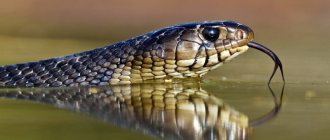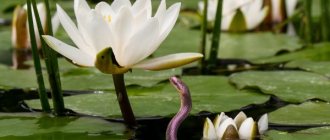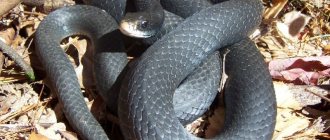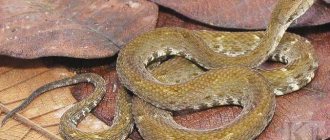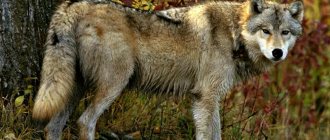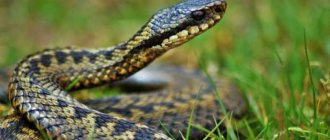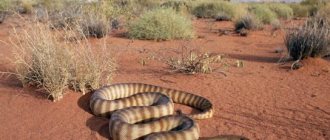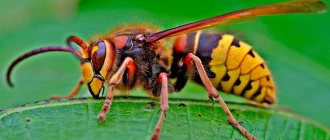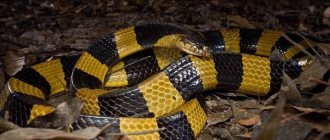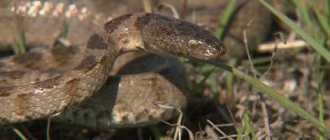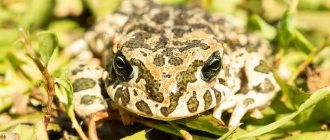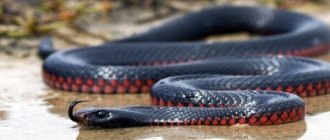Australia is one of the most beautiful countries on our vast planet, but alongside its natural beauty there are also many dangers. Very dangerous snakes in Australia can lie in wait in the most unexpected places.
In Australia they can be found everywhere, and local residents are no longer surprised to encounter reptiles in a store or in their own bathroom. Snakes in Australia are represented by 240 species, and today we will tell you about the most dangerous representatives of the Australian fauna in our short review.
List of the most dangerous snakes in Australia:
1
Tiger Snake / Notechis scutatus
The snake, whose adults grow up to 2 meters, chose the southern coast of Australia, New Guinea and the island of Tasmania as habitats.
A beautiful snake from the Aspid family has an olive body color with a reddish tint. It has a calm disposition, but sensing danger, it flattens its neck and quickly attacks, biting almost close to the ground. So high-soled shoes can save you from a fatal bite.
Due to the fact that the tiger snake's habitat is located in densely populated areas of Australia, a large number of bites are recorded annually. Numerous photos on the Internet confirm that she is a frequent guest of Australians’ apartments and houses.
2
Appearance and features
Photo: Poisonous tiger snake
The name tiger snakes refers to the prominent yellow and black transverse stripes typical of some populations, although not all individuals have this coloration. Snakes range in color from dark black to yellow/orange with gray stripes to sandy gray without stripes. There are unconfirmed reports of pot-bellied tiger snakes in north-east Tasmania.
Typical forms are black snake without stripes or with faint yellow to cream stripes. The most common form is dark olive-brown or black-brown, with off-white or yellowish stripes that vary in thickness. In striped populations, completely colorless individuals can be found. Some populations consist of almost completely dissociated members of the species, for example, residents of the central highlands and south-west Tasmania.
Interesting Fact: The coloration mechanism develops most strongly in populations exposed to highly variable weather conditions and cool extremes, such as those experienced at high altitudes or on offshore islands.
The tiger snake's head is moderately wide and blunt, slightly different from its strong, muscular body. The total length is usually about 2 meters. The belly is pale yellow, white or gray. Male tiger snakes reach larger sizes than females and have larger heads. The median scales consist of 17-21 rows, and the ventral scales 140-190 are often edged with black. There are also single anal and subcaudal scales on the underside of the tail.
Reticulated Brown Snake / Pseudonaja textilis
In terms of the toxicity of its venom, this representative of the asp family ranks 2nd among all land snakes living on our planet.
Despite its peculiar name, the color of adult individuals varies from light yellow to black and silver. The aggressive snake has chosen the arid regions of the east coast of Australia as its habitat.
In many cases, the willful reptile prefers to avoid confrontation, but if provoked, it will defend itself fiercely. You need to be especially careful, as the animal often gets into residential and outbuildings.
3
Western Brown Snake / Pseudonaja nuchalis
The snake, also called guardar, has chosen almost the entire territory of Australia, except for the wettest regions of the eastern part of the continent and the southwestern coast of Western Australia.
The western snake is not as aggressive or venomous as its eastern cousins, but its bites are also responsible for the majority of deaths recorded on the continent.
Since the venom is not very toxic, when they bite, they release a large amount of poison into the victim’s body, which, without timely help, leads to death.
4
Small but dangerous: sand efa
Habitat: India, North African countries, Turkmenistan, Uzbekistan, Tajikistan, Arabian Peninsula, Iran, Iraq, Afghanistan.
According to experts from the University of Melbourne, more people die from the bites of sand ephas, Russell's vipers and related species than from the bites of Australian reptiles. For example, the bite of this small snake, which is usually 50–60 cm long, is enough to kill five people.
Consequently, the most poisonous snakes in the world do not live in Australia, but in Africa and Southeast Asia.
Inland taipan / Oxyuranus microlepidotus
This dangerous snake hides in rocky crevices inside the mainland, and is dangerous because it has one of the most toxic poisons. If an antidote is not administered within 40 minutes after the bite, the person dies.
During a hunt, the Australian taipan injects a large amount of poison into the body of the victim, which instantly leads to death.
Interestingly, in the vastness of Australia there lives a harmless snake that has the same color and body structure as the poisonous taipan.
African boomslang
The venom of this reptile is very strong. It instantly acts on the cells of a living organism. After a bite, life counts in minutes.
Experts conducted experiments on small animals. After the African snake delivers its fatal bite, the victim becomes paralyzed. After 10 minutes the animals stop breathing.
Boomslang lives in Africa. He loves to hide on tree branches. This is how the snake camouflages itself. Boomslang can also be found in bushes, where it feels right at home.
Coastal Taipan / Oxyuranus scutellatus
Unlike its relative, this type of taipan has chosen the coast of Australia, starting from the north of the continent, arcing around the east and ending with the southern regions.
When meeting, it is better to bypass such a taipan, since at the moment of meeting a person it freezes, and then makes a swift throw that is simply impossible to dodge. Another danger is that during an attack it bites several times, introducing a large amount of poison into the body.
Note that this taipan has the longest fangs among all Australian snakes, growing up to 13 mm. TopCafe strongly discourages you from approaching such an animal.
6
Great Flattail
Scientific name: Laticauda semifasciata LD 50 Value: 0.111 mg/kg (saline)
The great flat-tailed sea snake, or Chinese sea snake, is a highly venomous species of sea snake widely distributed in the southwest Pacific Ocean. They are usually found near coral reefs; hunting eels and small fish through coral and reef cracks. Although the sea snake is a solitary creature, the large flattail often teams up with larger fish species to catch small prey.
In a 2022 study, researchers discovered a new population of greater flattail on the southern coast of South Korea, far from its normal range. A continuing pattern of northward migration has also been identified, with climate change being one of the main reasons for this.
Mulga / Pseudechis australis
One of the largest, with a massive body, the venomous snake of Australia lives in almost all parts of the continent, except for two states - Tasmania and Victoria.
It grows up to 3 m in length, and when bitten, releases up to 150 ml of poison into the victim’s body. An antidote must be administered within an hour after the bite, otherwise the likelihood of death is very high.
Interestingly, the habits of the mulga vary depending on the region where it lives. Southern individuals are calmer, but those living in the north are dangerous and aggressive. Mulga feeds on small rodents, lizards, and can hunt aquatic inhabitants of Australia, as well as birds.
7
Social structure and reproduction
Photo: Poisonous tiger snake
Males can be mature at a mass of 500 g, and females at a mass of at least 325 g. At the beginning of the breeding season, males engage in a fight in which each of the two contenders tries to pin each other with their heads, and as a result, the snakes' bodies become intertwined. Sexual activity in these reptiles is sporadic throughout the summer and reaches a peak in late January and February. Mating can last up to 7 hours, with the female sometimes dragging the male. Males do not eat during periods of sexual activity. Females stop eating 3-4 weeks before giving birth.
Interesting fact: They are viviparous animals. Female litter sizes have been recorded as high as 126 juveniles. But basically it is 20 - 60 live cubs. The number of babies is often related to the size of a woman's body.
Tiger snakes from small islands are smaller in size and produce fewer offspring. The length of tiger snake cubs is 215 - 270 mm. Females give birth to cubs every second year at best. There is no maternal care among tiger snakes. They don't become more aggressive during the breeding season, but a male snake tracking a female may well be focusing on other things.
Mating late in the season is beneficial for southern species, giving them the opportunity to begin breeding before spring. On the main island of Tasmania, mating has been observed lasting up to seven hours. Powerful females can be relatively sedentary; one heavy female in Tasmania remained in her "home" for 50 days. In southwest Australia, females give birth to their babies between late summer and mid-autumn (17 March - 18 May).
Death Adder / Acanthophis antarcticus
The small Acanthophis antarcticus, growing up to 1 m in length, prefers wooded and shrubby regions of the continent. It is active at night and feeds mainly on birds, small rodents and other snakes.
Due to the unusual shape of the head, it has a very menacing appearance, and the brown body is decorated with transverse dark stripes. It attacks its prey from an ambush, in which it can remain motionless for hours, only slightly twitching the tip of its tail, using it as bait.
It doesn’t attack itself, but you have to be careful not to step on the deadly snake, since experts note that it only bites if you touch it.
8
Magnificent Denisonia / Austrelaps superbus
The magnificent Australian copperhead snake chooses swampy places to live, as well as mountainous areas and valleys.
Adult individuals reach sizes up to 1.5 m in length, and because of the copper color of the head, they received their specific name. It hunts mainly in the daytime, eating frogs, lizards, and small rodents.
It feels great in water, and therefore can often be found near reservoirs. When bitten, it releases poison containing a neurotoxic substance into the victim’s body, which is why its bite is very dangerous for human health and life.
9
Red-bellied Black Snake / Pseudechis porphyriacus
Of all the Australian snakes, the black red-bellied snake is not very poisonous, but people remember its bite for a long time. Quite a curious reptile, and can often be found in the most unusual places - on city sidewalks or in the backyards of country houses.
The two-metre snake is often seen around Sydney and Melbourne, and due to its large size, it can eat other snakes. When in danger, it inflates its neck, like a cobra, and hisses threateningly.
The poison, entering the human body, affects the nervous system and blocks muscle activity, which can lead to serious health consequences.
On TopCafe.su you can find out the most interesting facts about Australia.
10
Philippine cobra
The classic image of a cobra is known to everyone due to its expanding ribs, forming a kind of hood. Compared to other venomous snakes, they are not that dangerous, but not the Philippine variety. Its venom is strong in itself (stronger than that of other cobras), and a cobra can inject up to 250 mg of it in one bite, and this is enough to send several people to heaven. Death can occur within half an hour after the bite, so people often simply do not have time to use long-established antidotes, since the progressive paralysis of the muscles of the respiratory system is often impossible to stop. But the Philippine cobra is especially dangerous because it is capable of not only biting, but also spitting poison into the eye from a distance of up to 3 meters.
Blackish Hidden-Eyed Adder / Rhinoplocephalus nigrescens
This dangerous snake is distributed along the entire eastern coast of the mainland, and often approaches towns and cities.
Rhinoplocephalus nigrescens, growing no more than 50 cm, has a highly toxic poison. Therefore, when spotted indoors or encountered in the wild, extreme caution must be exercised.
She is nocturnal and, due to her black color, is almost invisible. But he has a rather peaceful disposition, and attacks people only in the most rare cases.
11
Amethyst python / Morelia amethistina
Let’s complete our review of dangerous snakes in Australia with a large python, which received such a beautiful species name because of its color. The peony is listed as an endangered species and is protected by law.
The largest individuals ever discovered in the vastness of the Green Continent reached a length of up to 6 m. It chooses secluded places to live, and spends most of its life in trees or in rocky folds of rocks.
Amethyst pythons feed on small mammals and birds, and often attack small kangaroos - wallabies.
If you are interested in the fauna of Australia, then you will be interested in reading our article on TopCafe about the most amazing spiders of the Australian continent.
?
Malay krait
This mammal has a striped color, reminiscent of a traffic controller's baton. The bright black and white color hides the aggressive nature of the reptile.
After its bite, every second person dies, and it does not matter whether the victim received a healing vaccine or not. So far, scientists have not been able to invent a 100% antidote to the Malayan krait.
This insidious snake lives in Australia and southern Asia. There are often cases when this animal enters private houses and scares their owners. The Malayan krait loves to huddle in small burrows. And when he crawls out, he often crawls into dense thickets of bushes and trees.
